We all know Chess, right? Are there any similar modern games? Maybe a bit simpler and with more theme? This article compiles them into a list of the 10 Best Abstract Board Games in 2024.
Introduction
There are some properties that abstract games have in common (as always, there are exceptions):
- They lack a theme or the theme is “pasted-on”, meaning it would play the same with a different theme.
- Normally for 2 players.
- They have short, elegant rules, making them ideal for introducing new players to the hobby.
- Have little luck or hidden information.
- A simple rule set allows for clever plays, often requiring a lot of time and dedication to master.
This article was last updated in October 2024.
The List of Best Abstract Board Games
Click on a title to jump to that part of the article directly.
There are affiliate links by the titles. I am affiliated with Amazon (as well as with some other stores) and will earn a commission if you buy something through my link.
10. Hive
Designer: John Yianni
Year published: 2000
Playing time: 20 minutes
Rules complexity: medium
Long-term appeal: medium
Players: 2 only
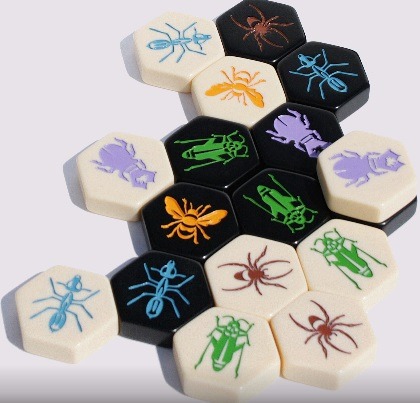
Overview of the Rules
Each player starts the game with 11 hexagonal tiles, depicting the following animals:
- One Queen,
- two Spiders,
- three Ants,
- two Beetles, and
- three Grasshoppers.
On their turn, the player will either:
- place a new tile or
- move an existing one.
The object of the game is to encircle the opponent’s queen. But this is easier said than done because there are several restrictions:
- You can’t place a piece next to your opponent.
- You must place the queen on your fourth turn or before.
- Each animal has its pattern of moving (beetles can climb onto others, blocking their movement; grasshoppers can jump over other pieces, spiders move exactly three pieces, ants only move on the outside, and the queen moves only one tile at a time).
- Your pieces must stay connected at all times – form a single Hive.
- Animals can’t move if they are surrounded (except for the grasshopper and the beetle).
- If you can’t move, you pass the turn.
Expansions/Editions
New pieces (Mosquito, Pillbug, and the Ladybug) are available as separate expansions, but also as part of some base game editions.
Another thing to look out for when buying, is that there is also a “pocket” edition of all the pieces. The game is the same, but the pieces are smaller, making them incompatible with the “carbon” version.
The version I recommend is in the link below.
Test of Time
Like many of the games on this list, Hive is one of those easy-to-learn, hard-to-master games. It requires similar skills as chess: spatial awareness, abstract thinking, predicting several moves ahead, and trapping the opponent.
It’s very challenging. You are not restricted by the board boundaries (there is no board), so you must think outside the box (or outside the board :)), which adds another layer to an already big brain-burning game.
Hive is around for 20 years, which is a decent time for a modern board game. Its elegance with room for advanced strategy has rightfully kept it on the shelves for so long. It’s also really cheap.
It has a tiny footprint and the games are quick, making it ideal for travel or outside play. It can be packed in a bag and taken anywhere. There’s no set-up time – you just take your pieces and start placing them.
Standout Features
- Achieves a surprisingly deep strategy with minimalistic components.
- Great for traveling.
- Can be a real brain-burner.
9. Tiny Towns
Designer: Peter McPherson
Year published: 2019
Playing time: 45-60 minutes
Rules complexity: light
Long-term appeal: low
Players: 1-5, best with 3-4
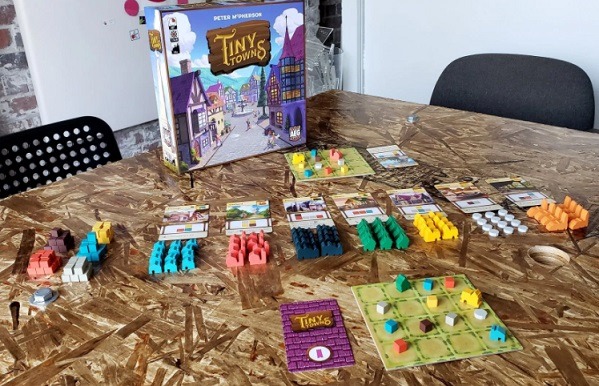
Overview of the Rules
Each player takes a personal board: a 4×4 grid. A set of cards, representing buildings is laid out in the common area. Each building shows a layout of colored cubes, which is the prerequisite to building it.
On your turn, you will first call out one resource (color). Each player must then place a cube of that color on their grid. When you complete a pattern for a building, you remove the cubes and you can place a building on one of the tiles previously occupied by those cubes.
When your city grid is full and you can no longer add cubes or buildings, you’re done. Your score is calculated based on the buildings you own. Some score more and there are also bonuses for adjacency.
Other players continue the game until every one of them has filled their board. Then the scores are compared and the winner is declared.
Expansions
Two expansions have been added in 2020:
- Tiny Towns: Fortune adds the mechanic of money.
- Tiny Towns: Villagers adds meeples.
Test of Time
Tiny Towns is a very simple game. Anyone can play in a matter of minutes, yet there is a chance for a good player to dominate.
There is little to no luck – if you are perceptive enough, you can follow all the other boards, predict what other players need, and thus always make a perfect move.
That does require plenty of skill, spatial awareness, and an analytical mind, fortunately. If everyone possessed these qualities, Tiny Towns wouldn’t be much of a game.
Despite this, the longevity of this game is not great. Yes, it’s good fun and will tickle your brain, but gamers who like a bit more depth will outgrow it soon.
The expansions add a bit more juice to it, but I don’t see anyone writing books studying Tiny Town strategies.
When it comes to playing time, I believe the game outstays its welcome slightly, but if you take it as a casual, filler game, it will provide plenty of entertainment.
Standout Features
- Simple rules.
- Fun puzzle.
- Nothing more than a casual board game.
8. Onitama
Designer: Shimpei Sato
Year published: 2014
Playing time: 15-20 minutes
Rules complexity: light
Long-term appeal: medium
Players: 2 only
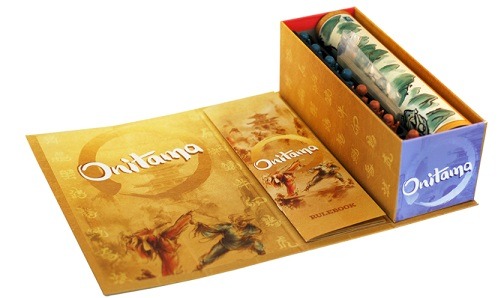
Overview of the Rules
Imagine chess, only with a smaller grid, fewer pieces, and a dynamic, card-driven movement mechanic. That’s Onitama.
The game is played on a 5×5 board. Each player controls 5 pieces: 1 master and 4 apprentices. The goal of the game is to get your master across to the other side or to capture the opponent’s master. Capturing is done by moving one piece onto another, just like in chess.
Movement is where it gets interesting.
Every player has two cards in front of him. Possible movements are displayed on them with a grid. There is a fifth card beside the board.
On your turn, you will choose one of your cards and move a piece according to the chosen card. Then the used card is replaced with the fifth card.
The opposing player then chooses one of his cards, moves, and exchanges that card with this fifth card — which is the card the first player just used.
Turns continue until one of the players wins the game.
Expansions
- Onitama: Sensei’s Path (2017) adds 16 new movement cards.
- Onitama: Way of the Wind (2018) adds a neutral, impassable object, that both players can move.
Both expansions are a welcomed addition. There is a larger box, containing both of them, available as well.
Test of Time
Rules of Onitama can be taught in minutes. Another minute to prepare the board and draw 5 cards from a deck of 16.
Then the fun begins. Immediately, you’ll find yourself in a deep zen-like state of mind (goes nicely with the art style), analyzing the board, and predicting enemy moves. This is all thanks to the genius card-movement mechanics.
You can see your opponent’s cards all the time. You know what they can do and with which piece would they ideally move. But you also have to take into account the dynamic back-and-forth of the movement cards. You can take that powerful move, but that means your opponent will have access to that card in a couple of turns.
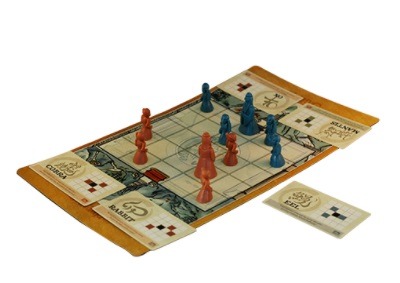
It all comes to risk, reward, and prediction. Taking the most beneficial move and not giving your opponent a chance for a good move. And at all times, predicting not only the movement of the pieces but also how the cards will trade owners as well.
Now add that you only use 5 cards per game out of a possible 16 and you can see how many variables and different strategies the game offers. Add expansions and you’re good for a while.
Standout Features
- Elegant card-driven movement mechanics.
- A lot of replay value.
- Great balance between depth and playing time.
7. Photosynthesis
Designer: Hjalmar Hach
Year published: 2017
Playing time: 30-60 minutes
Rules complexity: light
Long-term appeal: medium
Players: 2-4

Overview of the Rules
Photosynthesis, a game of growing trees, is played over 12 rounds (three full revolutions of the Sun around the board), with each of the rounds consisting of two phases:
- In the Photosynthesis phase, “the Sun” is moved around the board clockwise. Players receive light points, depending on how many (and how large) trees they have on the board. Trees also cast shadows – large trees can cast a shadow over smaller ones, preventing them from scoring.
- Now comes the Life Cycle phase. Players can now spend their light points to:
- buy (putting seeds and trees on their player board),
- plant (transferring them to the main board),
- grow (small trees into medium and large) and
- chop down trees (earning more victory points, the closer the tree was to the center of the board).
You can only interact with a tree once per round, so some planning is required to optimize your processes.
Expansion
Under the Moonlight (2020) adds some much-needed complexity. The Moon casts moonlight and is placed opposing the Sun. You can spend lunar points to activate 8 new forest animals (which come in the form of animeeples) with their special abilities.
You place the animals on the main board: the boar collects trees, the hedgehog plants seeds, the fox steals and moves seeds around, and the owl turns lunar points into sun points.
Test of Time
While some of the games on our list are absolute brain burners, Photosynthesis isn’t one of them. It’s more of a laid-back, relaxed experience.
Yes, there are a lot of interactions (especially with the clever shadow mechanics) on the main board, and for optimal play, you can do a lot of analysis if you want to. But that’s not the point of the game. It’s about helping trees grow and developing your engine.
The game is fun and casting a shadow over another player’s tree always brings a grin to your face. But I don’t see anyone playing Photosynthesis too competitively, it’s just not that kind of a game. Its long-term appeal is that it’s a fun family-friendly game.
Standout Features
- Fantastic presentation.
- Simple, intuitive rules.
- A great family game that works well with all player counts.
6. War Chest
Designers: Trevor Benjamin, David Thompson (I)
Year published: 2018
Playing time: 30 minutes
Rules complexity: medium
Long-term appeal: medium
Players: 2 or 4, best with 2
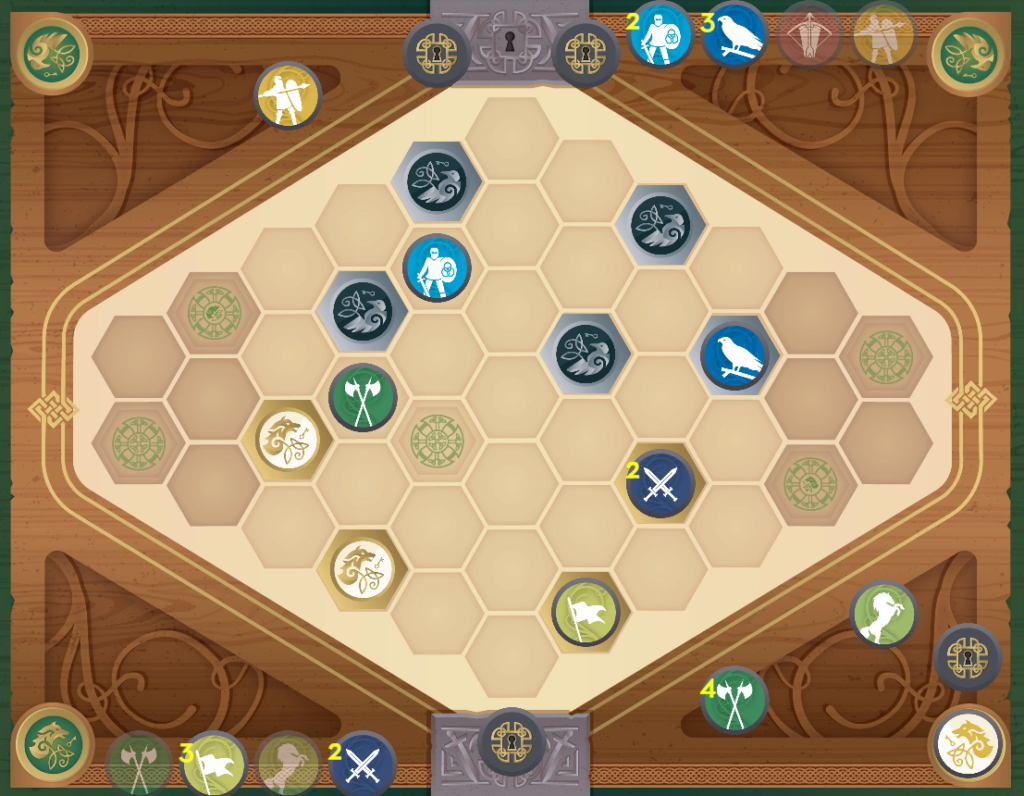
Overview of the Rules
War Chest is played on an abstracted hexagonal grid. It’s predominantly a 2-player game, although it can also accommodate 4.
Your goal is to be the first to place six control markers on the map. Your main tools are your poker chips of several types.
Each turn, you will randomly grab three of them from your bag and you have three options on what to do:
- You can place them on the board, transforming them into a unit of a certain type. If you place it on top of an existing unit of the same type, you make it stronger.
- To activate a unit, you must discard your chip face-up. It must, of course, be of the same type. You can then move, attack, place a control marker, or use the unit’s tactic.
- You can also discard the chip face-down, which gives you options to draw a new one, pass a turn, or claim the initiative for the next round.
If you run out of chips, you put the discards back into the bag and repeat the process until someone places the aforementioned six control markers.
Expansion
War Chest: Nobility (2019) adds new noble units and royal decrees.
Test of Time
There are 16 units (each with a count of 4 or 5 chips) in the game, but you will only see four per player in a single game. This creates a lot of variety and replay value, but also creates a slight problem of balance since some units feel stronger than others.
Each unit comes with special movements, rules, and tactics (all explained on the corresponding cards). Cavalry is faster, infantry is stronger but slower, archers are good at range, and so on.
Combining the strengths of different units and creating powerful synergies on the battlefield is what wins games. It’s very similar to chess, with the addition that you always need a chip to activate a unit.
War Chest is a bag-builder. The draw is random, but you do have some influence over it. You at all times know what is left in the bag and what the odds of drawing a certain chip are.
If you don’t like what you drew, you can discard it face-down and draw another chip, increasing the chances of getting what you need. In fact, discarding face-down is a crucial part of the strategy, since it keeps your opponent guessing your remaining chips and possible moves.
Not counting the draw (which can be manipulated), there is little luck in War Chest. It comes down to wise strategic and tactical decisions. With the variety of units (especially when combined with the expansion), War Chest will keep you occupied.
Standout Features
- Sleek design with tactile components.
- Easy to learn and has a lot of room for skilled players.
- Plenty of variety and replayability.
5. Santorini
Designer: Gordon Hamilton
Year published: 2016
Playing time: 20 minutes
Rules complexity: light
Long-term appeal: high
Players: 2-4, best with 2
Overview of the Rules
Santorini (using the beautiful island’s architecture as a theme) succeeds in accomplishing the impossible: creating a 3D puzzle, that is compelling, transparent, and functional.
The object of the game is to move on top of a level 3 building and to prevent your opponent from doing the same thing.
Both players (although 3 or 4 can play, it works best with 2) start with two workers on a 5×5 grid. On your turn, you must do two things:
- Move a builder. You can move one space (not containing another worker or a blue dome). You can also move up one level or drop down levels.
- You build on an adjacent building. On an empty space, a level 1 building is erected. This house can be further heightened to levels 2 and 3. Finally, a blue dome can be placed on top of level 3, completing the building.
Placing a blue dome also blocks it from moving onto, making this building ineligible for victory conditions. The building is also not restricted by height difference, meaning you can build level 3 if you are on the ground adjacent or vice-versa.
When one of the workers moves onto a level 3 building, the player wins immediately. An alternative way of winning is to block your opponent so that he can’t move and build, but it’s a rare occurrence.
Expansion/Edition
Santorini: Golden Fleece (2017) is an expansion that adds an alternative way of playing. It adds the Fleece statue (adding a mechanic when players can use common God powers), more God cards, as well as Hero cards, which offer another set of special abilities but are weaker than God cards.
Santorini: New York (2020) is a standalone game. The basic mechanics are pretty much the same, but tweaks to the grid, buildings, and powers make the game different just enough to warrant a purchase.
Test of Time
To mix things up, there are the optional God powers cards. You take (or draw) one at the start of the game, granting you special powers like building extra levels, pushing other workers around, having an extra move, alternating victory conditions, and so on.
There are 30 God cards and another 25 in the Golden Fleece expansion, creating a lot of combinations. Some combinations may be a bit unbalanced, but there are always options to house-rule the draft to even the odds.
If you play vanilla Santorini (without any special cards), it is a brilliant deterministic 3D puzzle. There is a lot to think about, but it never stresses you out.
But adding all the variables (special powers and/or the Golden Fleece) is what makes a game out of it. You can use several combinations, each creating a different game. Do Gods’ powers have too much of an influence? Use Hero powers instead. Want to try something new? Take the Golden Fleece statue.
Taking into account the phenomenal components (which never deter the overview of the situation), quick game time, endless replayability, and all-age accessibility, you’ll play Santorini for years.
Standout Features
- Beautiful presentation.
- Simple rules, but offer plenty of strategic depth.
- A lot of possible combinations with power cards
4. Go
Designer: unknown
Year published: around 2200 BC
Playing time: 30-180, depending on board size
Rules complexity: light
Long-term appeal: high
Players: 2 only
Overview of the Rules
Go is played on a 19×19 grid. This is the standard size, although smaller boards are used if you want the game to end sooner or you’re still new and want to reduce the complexity a bit.
Two players face each other with black and white stones. The stones can be placed on intersections anywhere on the board. Black goes first, then they take turns – each time only placing one stone.
The object of the game is to claim as much territory – this is done by encircling enemy stones which are then removed from the board or by walling out certain sections of the board.
The game ends when the board fills up (there’s nowhere left to place a stone) or, more commonly, with a mutual agreement. Often, the winner will be clear earlier and there’s no reason to prolong the play.
Test of Time
Go is one of the oldest board games on the planet, dating back over 4 millennia. Although the placing of stones is one of the simplest rules imaginable, the strategy goes way deeper than this.
Several small battles are fought on the board at all times and you must decide whether to place a stone at one of them, perhaps forfeiting others. Or maybe start a new battle at the other end of the board.
Decisions are not easy and one misplaced stone can be the difference between winning and losing. Having the whole situation in your head is a real brain-burner, that’s why novice players are advised to start on a smaller board, where they can grasp the situation with less difficulty.
You can get starter sets (with plastic board and stones) relatively cheaply, but investing in Go should be a long-term engagement. Therefore, only a set with premium materials (board made of shin kaya wood, with glass stones and bamboo bowls) is worthy of a classic game like Go.
Standout Features
- Elegant board, pieces, and rules.
- A day to learn, a lifetime to master.
3. Chess
Designer: unknown
Year published: around 15th century
Playing time: 60 minutes
Rules complexity: medium
Long-term appeal: high
Players: 2 only
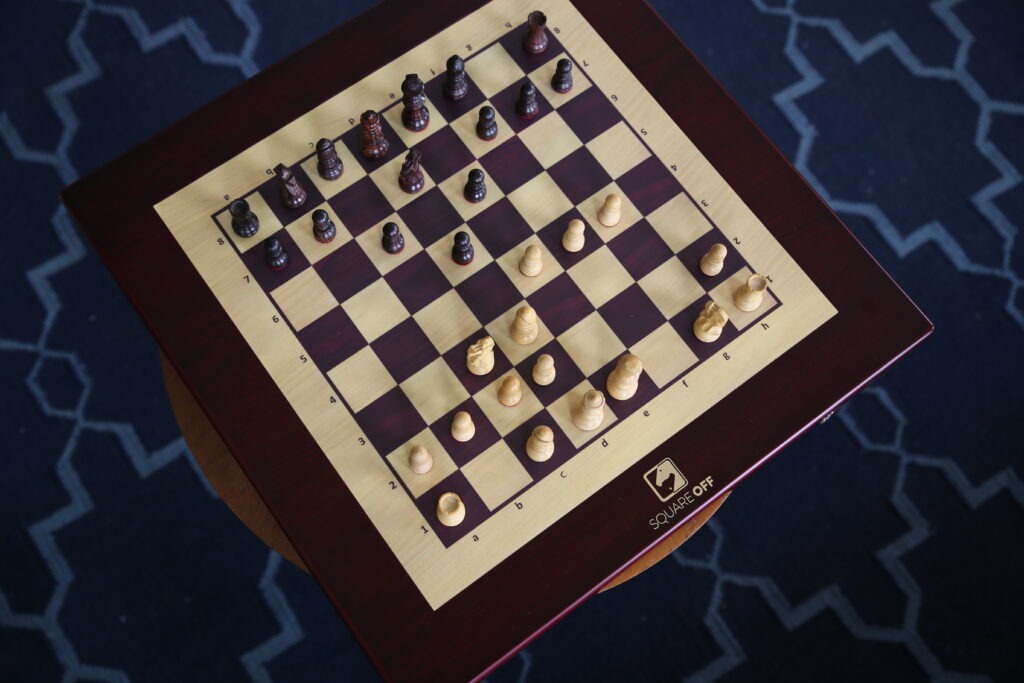
Overview of the Rules
Chess is played on an 8×8 board, with black and white tiles. Each side starts with 16 pieces: eight pawns, two bishops, two knights, two rooks, one queen, and one king. The pieces start arranged in the bottom two rows.
Every piece follows specific move rules: pawns can only move forward, rooks move on lines and rows, knights can jump over other pieces, and bishops move on diagonals. The Queen is the most powerful piece, combining the movement of both rooks and knights. So can the most important piece, the King, but he can only move one space at a time.
The white has the first move. You can move any piece you want, as long as the move is valid. If the opponent’s piece is in your way, you can capture it (remove it from the board).
The object of the game is to checkmate the enemy King. The Kings cannot be captured – when a piece is threatening to capture a King (so-called “check” is declared), the latter must respond immediately by moving out of the way or cancel the check by blocking it with another piece.
If there is no option to cancel the check (nowhere to move the King or block), the “checkmate” is declared and the King is defeated. There is also an option for a draw – if one of the players cannot perform a legal move or neither of the players can checkmate the other.
Test of Time
While the basic rules, like setting up the board and how the pieces move can be learned relatively quickly, mastering the game of chess is another thing entirely.
Chess is about positioning, analyzing how the pieces work together with one another, setting up moves several turns ahead, and trying to squeeze the opponent into the corner.
There is no luck present in the game of chess – if you play against a better player, you will lose pretty much all the time. There is an option to handicap better players by limiting their time (using a chess clock), which is a great way to level the field.
Countless books, studies, and computer versions are available. In fact, chess was a measure of computer power for a long time – it was only in the late 90s that a computer could beat a human grandmaster for the first time.
Chess has stood the test of time. It’s over 500 years old, everyone knows what it is and many people can play it competently. If you want to play competitively, there is still a large active community and you can find games easily. Not to mention the ability to play against a computer.
As everyone has a chess set at home (or can buy it cheaply everywhere), there’s no point in recommending one. Rather, I will recommend a premium set, that will be a remarkable piece of furniture and impress visitors.
Standout Features
- Relatively easy to learn, especially compared to the overall depth.
- Has reached mainstream popularity – everyone knows the basics or has at least heard of it.
- Can take a lifetime to master.
2. Patchwork
Designer: Uwe Rosenberg
Year published: 2014
Playing time: 15-30 minutes
Rules complexity: light
Long-term appeal: medium
Players: 2 only
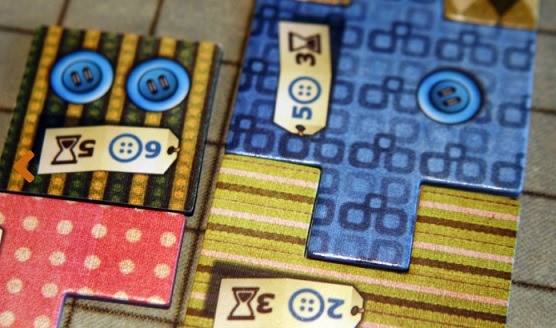
Overview of the Rules
In Patchwork, two players are trying to build a patch of cloth on a personal board (9×9), using tiles of different types and sizes.
The tiles are laid out randomly in a circular shape and a marker is placed on a designated place in that circle.
Every turn, a player can purchase one of three patches placed clockwise of the marker. He must pay the required amount in currency (buttons) and move the marker to the now-empty spot in the circle. The larger, more desirable patches are more expensive.
You place the patch on your grid and must advance the time token by the number on the patch.
Buttons are used as currency, and each tile has a cost to place. If you don’t have enough money, you can move your time marker one space in front of your opponent, forfeiting your turn, but earning one button for each space moved.
Another way to gain currency is when passing a button yield marker on the time track marker board, activating income.
When both of the players reach the end of the time marker, the game ends, and scoring begins. You get points for unused buttons and negative points for uncovered spaces on your board. You can also get bonus points if you’re the first to complete a 7×7 patch. The player with the most points wins.
Read the full Patchwork Review
Editions
Patchwork Express is an even simpler version of the game, particularly aimed at young kids. With a smaller 7×7 personal board and larger, less complex pieces, it’s an ideal way to introduce your 5yo kids to board gaming.
Patchwork: Automa (2018) is a 24-card deck, enabling single-player play.
Test of Time
The gameplay is a mix of trying to fit the tiles nicely together, while keeping track of your money, calculating how much to spend and how much you will get back from it in the future.
Time is the second resource (after buttons) and managing it is a very important aspect of the game. It’s always worth considering spending less time – taking two smaller patches instead of one larger. Or, if played correctly, place a small and still have time to place a larger piece next.
See, the player that is last on the time track always goes first, so it’s possible to have several consecutive turns. But being in front also has its benefits: free single-square pieces, which are sometimes the only way to fill out your grid.
Manipulating the patch marker is another strategic layer. As it always moves to the previously taken patch, you can move it in a way that is harmful to the opponent, but helpful to yourself.
You’re always balancing between your money (buttons), time (initiative), and patches (available real estate). It’s about efficiently managing those three variables to beat your opponent.
Patchwork is an excellently balanced game and frankly, you wouldn’t expect anything less from Uwe Rosenberg. Although it plays elegantly, smoothly, and is fun, its long-term appeal is rather questionable. There’s just not enough of the game in there to be more than an occasional “quickie” experience.
While the patches look and feel nice, the theme feels extremely pasted-on and not at all exciting. With all due respect for the textile industry, making cloth is not an adventurer’s life.
But what if you took some of the mechanics in Patchwork and used them as a part of a larger, much more complex board game? Let me introduce you to A Feast of Odin.
Standout Features
- A game of economic balance, wrapped as a tile-placement game.
- Easy rules, fast gameplay.
- An ideal introductory game for newbies.
1. Azul
Designer: Michael Kiesling
Year published: 2017
Playing time: 30-45 minutes, depending on player count.
Rules complexity: light
Long-term appeal: high
Players: 2-4
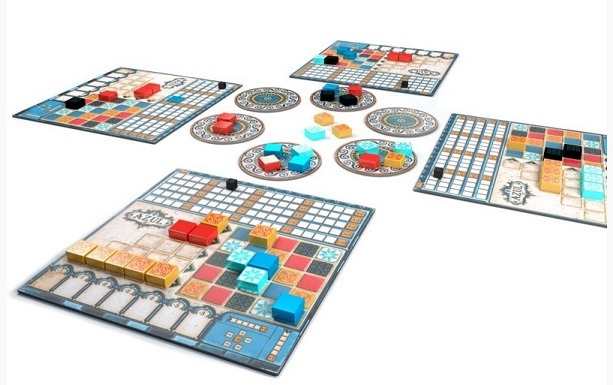
Overview of the Rules
In Azul, players collect sets of tiles from the central offer and place them on their player boards, forming collections and patterns of five different colors, and scoring points for those patterns. Here’s how it works.
In the center, there are a certain amount of factories (there are five for a 2-player game), each offering 4 tiles. Players alternate turns picking which factory to collect.
When collecting, you take all the tiles of the same color that are in that factory. The rest is moved to the center pile, forming a “wild” factory.
From now on you can also choose to take from the center factory, but the first player to do so in a round will get one negative point (but will get the first player marker for the next round).
You place the collected tiles on one of the five rows on the bottom left of your player board. The top row requires only one tile to fill, the second requires two, all the way down to the fifth, which requires five tiles of the same color to fill.
The round ends when there are no more tiles on offer. Filled rows are then scored and one tile from that row is moved to the right side, to the pattern. Unfulfilled rows remain as they were and you can continue to fill them in the next round.
The tiles that get moved to the right side are scored, together with bonuses for every adjacent tile already placed. When a tile is scored and moved to the right, that row is no longer available to be filled with that color.
When the first player completes a row on the right side, the game ends. Therefore the minimum playing time is 5 rounds. But it is usually longer, since rushing the game just to complete won’t yield any big points.
The tiles score more when placed adjacent both vertically and horizontally, there are bonus points for completed rows and columns, or by filing every tile of a single color.
Expansion/Editions
Azul: Crystal Mosaic is an expansion that adds new player boards (containing more challenging right-side tables) and plastic overlays, which prevent your tiles from sliding on the board.
Azul: Stained Glass of Sintra (2018) is a standalone game, that completely revamps player boards. You’re still collecting tiles, but this time you’re placing them in pattern strips and then moving them to complete palace windows.
Azul: Summer Pavilion (2019), another standalone title with player boards changed one more time. This time you’re collecting diamond-shaped tiles, and working on King Manuel’s Pavillion.
Azul: Queen’s Garden (2021) uses hexagonal tiles as you prepare a garden for Queen Maria of Aragon.
Test of Time
While Azul is a purely abstract game, the designers have squeezed every drop out of the theme. The tiles look and feel great and the whole game is a joy to behold.
The gameplay starts as a solitaire set-collecting, but soon things start to complicate. First, there’s the center factory. It will start to fill up with tiles that everyone will look to take. But who will be brave enough to take that negative point? Or should you push your luck and wait for one more turn?
As the game progresses and you close more and more tile slots on your right side, your options become limited. Suddenly, you’re not just looking for where you can get the most tiles, you’re looking for specific colors.
So are your opponents. Azul now becomes more competitive and tense, with players denying other players access to tiles they so desperately need.
But as there’s always an alternative as to what to pick, it never turns into a war, but rather friendly-competitive. You don’t stop the opponent from scoring, you just make them take the tiles that score fewer points.
Azul is a joy to play. The rules are easy to understand by everyone – collect these tiles of the same color until you have enough to fill a row. But being good is deceivingly hard.
As all the information is available and there’s no luck involved, an experienced player can absolutely destroy a novice. There is a lot of room for optimization, especially when it comes to scoring.
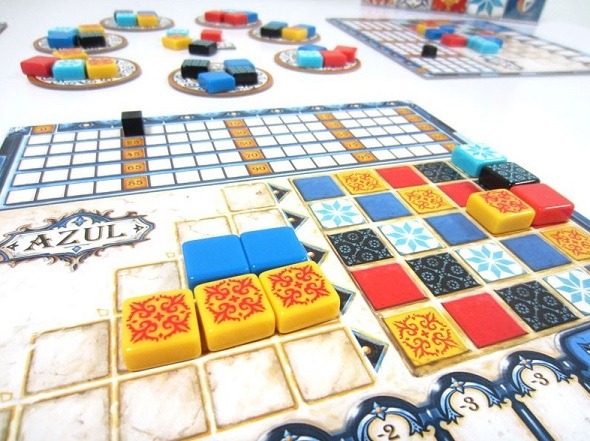
Azul is a game with an extremely low entry point, but a high bar for advanced players. There is a lot of depth and thought in your decisions. It looks fantastic, plays quickly, and works great with all player counts.
It’s no wonder it has quickly become a modern classic and the best abstract board game available. The sequels only confirm this – they offer changed game mechanics, but the beauty and elegance of the original Azul remain uncontested.
Standout Features
- Easy to learn, hard to master.
- Looks great on the table.
- A lot of replay value.
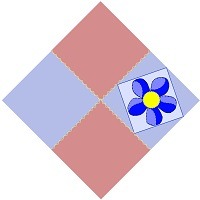
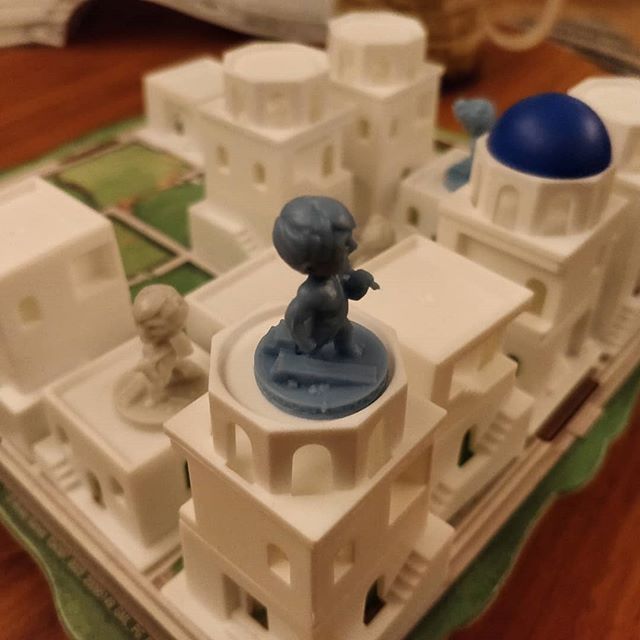

It’s just a perfect time for this article to be here, as I’m thinking of planning a getaway weekend for my family.
Board games are essential entertainment for us and they make trips fun. We’ve played Ticket to Ride, but it’s a bit clumsy to transport around.
These abstract board games are small and really interesting. Looks like they can be transported easily. I really like the look and compactness of Hive. Which game is also good for travel?
Hive is excellent for travel – all you need is a bag. I’d also suggest Onitama. A really small footprint, small bag. Very easy to carry around.
To be honest, I am a bit of an old-school, having played chess a lot back in my day. Bit it looks like it has lost some of the appeal for the youth these days.
By the looks of this article, there are many modern games that teach the same skills but are packed in a much nicer theme. I see how these would be great to introduce kids to logical thinking.
Lawson, you are absolutely correct! These games offer an excellent opportunity for kids to enter the board gaming world. But not just kids, adults as well. Board gaming has many benefits (abstract thinking, socializing) and is a great way to spend leisure time.
I’ve gone through your article and you’ve done a commendable job with the list and the tips dropped with it too. Although I don’t agree with it completely; I think Santorini should be higher on the list. 🙂
I also really like Tiny Towns, but you say that it’s nothing more than a casual game. What do you mean by that? Thank you
Hey Sophie!
What I meant is that it takes too long to completes, compared to the complexity of plays it allows. It may be a personal opinion, but for a 1-hour game, I want a full experience, not just one game mechanic repeated.
For such a small game, I prefer playtimes no longer than 30 minutes. You mentioned Santorini. That’s a great example!